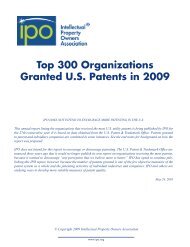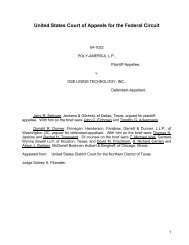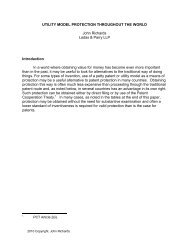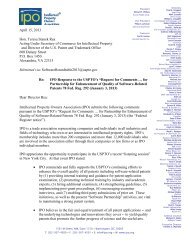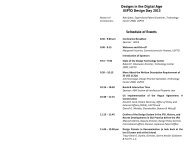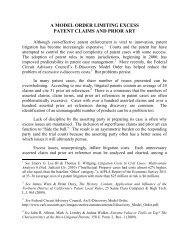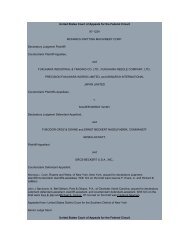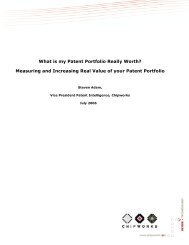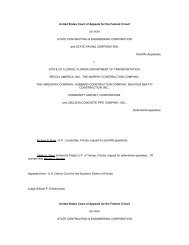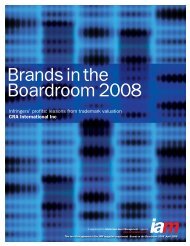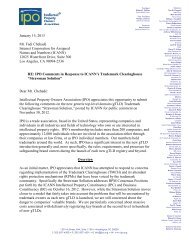Ruiz v. A.B. Chance Co.
Ruiz v. A.B. Chance Co.
Ruiz v. A.B. Chance Co.
You also want an ePaper? Increase the reach of your titles
YUMPU automatically turns print PDFs into web optimized ePapers that Google loves.
United States <strong>Co</strong>urt of Appeals for the Federal Circuit<br />
99-1557, -1563<br />
RICHARD RUIZ and FOUNDATION ANCHORING SYSTEMS, INC.,<br />
Plaintiffs-Cross Appellants,<br />
v.<br />
A.B. CHANCE COMPANY,<br />
Defendant-Appellant.<br />
W. Michael Gardner, Dady & Garner, P.A., of Minneapolis, Minnesota; and Matthew A. Rosenberg, Herzog,<br />
Crebs & McGhee, LLP, of St. Louis, Missouri, argued for plaintiffs-cross appellants. With them on the brief<br />
was Mark R. Dunn, Herzog, Crebs & McGhee, LLP. Of counsel was Cheryl A. Stanton, Dady and Garner.<br />
John H. Quinn, III, Armstrong Teasdale LLP, of St. Louis, Missouri, argued for defendant-appellant. With him<br />
on the brief was Andrew B. Mayfield. Of counsel was Lisa M. Wood.<br />
Appealed from: United States District <strong>Co</strong>urt for the Eastern District of Missouri<br />
Judge Catherine D. Perry<br />
United States <strong>Co</strong>urt of Appeals for the Federal Circuit<br />
99-1557, -1563<br />
RICHARD RUIZ and FOUNDATION ANCHORING SYSTEMS, INC.,<br />
Plaintiffs-Cross Appellants,<br />
v.<br />
A.B. CHANCE COMPANY,<br />
Defendant-Appellant.<br />
__________________________<br />
DECIDED: December 6, 2000<br />
__________________________<br />
Before NEWMAN, MICHEL, and RADER, Circuit Judges.<br />
MICHEL, Circuit Judge.<br />
The A.B. <strong>Chance</strong> <strong>Co</strong>mpany ("<strong>Chance</strong>") appeals the decision of the United States District <strong>Co</strong>urt for the<br />
Eastern District of Missouri finding claims 1 through 4 and claims 6 through 8 of U.S. Patent Nos. 5,139,368<br />
("the ’368 patent") and 5,171,107 ("the ’107 patent") invalid for obviousness under 35 U.S.C. § 103 (1999).<br />
On cross-appeal, Richard <strong>Ruiz</strong> and Foundation Anchoring Systems, Inc. (a/k/a "Fasteel") argue that the<br />
district court erred in the following rulings: 1) finding infringement of claims 1 through 4 and claims 6 through<br />
8 of the ’368 and ’107 patents; 2) denying recovery of attorney fees under 35 U.S.C. § 285 (1994) due to<br />
<strong>Chance</strong>’s alleged inequitable conduct; 3) concluding that neither party was prevailing for the purpose of<br />
awarding costs under Fed. R. Civ. P. 54(d); and 4) granting summary judgment against <strong>Ruiz</strong> and Fasteel on<br />
their claims of discrimination pursuant to 42 U.S.C. § 1981, breach of contract, breach of the implied duty of<br />
good faith and fair dealing, equitable and promissory estoppel, and tortious interference with contract and<br />
prospective business relations.<br />
Because the district court failed to make factual findings on obviousness as set forth by the Supreme <strong>Co</strong>urt<br />
in Graham v. John Deere <strong>Co</strong>., 383 U.S. 1, 17-18, 148 USPQ 459, 467 (1966), we must vacate the judgment<br />
of invalidity and remand to the district court. On remand, we instruct the district court to make<br />
specific Graham findings on: 1) the reason, suggestion, or motivation present in the prior art, in the<br />
knowledge of those of ordinary skill in the art, or in the problem of foundation settling which clearly and
particularly would lead one of ordinary skill in the art to combine screw anchors and metal brackets; 2) the<br />
level of ordinary skill in the art; and 3) whether, and to what effect, evidence of secondary considerations,<br />
such as commercial success, long-felt but unresolved need, failure of others, copying, and unexpected<br />
results, is probative in the obviousness analysis.<br />
We affirm the district court’s finding of infringement, and its refusal to award attorney fees and costs. We<br />
also affirm the district court’s grant of summary judgment on the non-patent claims.<br />
Background<br />
A. The <strong>Chance</strong> Patents<br />
Since the 1970s, <strong>Chance</strong> has manufactured and sold screw anchors, also known as helical anchors, for<br />
stabilizing and supporting electrical transmission over tower legs. A screw anchor consists of "an elongated<br />
shaft presenting an earth-penetrating tip and a transversely extending load-bearing member." ’368 patent,<br />
col. 2, ll. 32-35. In late 1988, <strong>Chance</strong> began using screw anchors with metal brackets to stabilize residential<br />
and commercial structures. The craft of stabilizing a sinking structure is known as "underpinning." In March<br />
1989, <strong>Chance</strong> engineers demonstrated a prototype of its invention to Richard Fuller and Stan Rupiper, who<br />
used a method of underpinning employing screw anchors with concrete haunches. As the district court<br />
noted, "[a]t that time, neither Fuller nor Rupiper made any indication that they felt they had already designed<br />
a bracket or had already been using a bracket or a support of the same type."<br />
In 1992, the Patent and Trademark Office ("PTO") issued <strong>Chance</strong> the ’368 and ’107 patents, entitled<br />
"Method of Underpinning Existing Structures," covering its methods for underpinning residential and<br />
commercial foundations using screw anchors and metal brackets. The ’107 patent is a continuation of the<br />
’368 patent, which in turn is a continuation-in-part of patent application serial number 07/464,937 (issuing as<br />
U.S. Patent No. 5,011,336 ("the ’336 patent")). The <strong>Chance</strong> patents are "concerned with an improved<br />
anchor apparatus designed to support and resist settling of structural foundations" particularly for "existing<br />
building structures having a predetermined weight and which may or has experienced settlement or<br />
movement." ’368 patent, col. 1, ll. 13-20. In the method claimed in the ’368 patent, the metal bracket<br />
connects the screw anchor to the foundation and transfers the dead weight and live load of the foundation to<br />
each screw anchor. See id., col. 2, ll. 20-26. Users of the method place the screw anchor adjacent to the<br />
footing, and then rotate and screw the anchor "below the footing until the upper end of the shaft is adjacent<br />
the footing and a predetermined resistance to rotation of the anchor has been achieved." Id., col. 2, ll. 31-39.<br />
"Upon release of rotational torque on the anchor shaft so that the anchor may return to its unstressed state,<br />
the anchor shaft and foundation and/or footing are connected via a [metal] bracket assembly to establish the<br />
desired load-bearing relationship." Id., col. 2, ll. 45-50.<br />
B. The Prior Art<br />
1. The Gregory Patents<br />
U.S. Patent Nos. 4,911,580 ("the ’580 patent") and 4,765,777 ("the ’777 patent"), issued to Gregory,<br />
disclose an apparatus and method for raising and supporting a structure using push piers and metal<br />
brackets. In the Gregory method, the user attaches a metal bracket to the foundation and drives the push<br />
piers through the bracket and into the ground until encountering resistance from soil friction or impinging<br />
upon bedrock. ’580 patent, col. 4, ll. 21-26. <strong>Co</strong>ntinued force lifts the foundation, and transfers the weight of<br />
the structure to the pier. Further movement of the foundation may take place following transfer of the load,<br />
particularly if the pier is held in place by soil or friction.<br />
2. The Fuller and Rupiper Method<br />
The Fuller and Rupiper method uses screw anchors with concrete haunches as an underpinning solution. In<br />
this method, popular in settings having high seismic activity such as California, the user excavates the earth<br />
around and beneath the foundation to install a screw anchor and to place steel reinforcing rods in the<br />
excavation. The contractor then pours concrete into the excavation and allows the concrete to dry before<br />
backfilling the excavation. In the concrete haunch method, the weight of the structure is not transferred to<br />
the screw anchor until there is further downward settlement of the foundation onto the hardened concrete.<br />
This method must also be performed in a specific sequence, as the screw anchor must be installed before<br />
the concrete hardens, and the resulting connection is formed.<br />
C. The Distributorship Agreement between <strong>Chance</strong> and Fasteel
In April 1989, <strong>Ruiz</strong> incorporated Fasteel to provide building stabilization services using <strong>Chance</strong>’s products<br />
and methods. <strong>Ruiz</strong> is Hispanic, and is the sole owner of Fasteel. In June 1989, <strong>Chance</strong> and <strong>Ruiz</strong> entered<br />
into a "Distributorship Agreement," whereby <strong>Chance</strong> appointed Fasteel to act as an authorized, nonexclusive<br />
distributor. The Agreement contained a "best efforts" clause. For the next few years, <strong>Ruiz</strong> and<br />
Fasteel sold <strong>Chance</strong> products exclusively and only used the <strong>Chance</strong> underpinning method. <strong>Ruiz</strong> and Fasteel<br />
also recruited dealers for the <strong>Chance</strong> method, created marketing materials, developed products, and<br />
conducted training programs. <strong>Ruiz</strong> extolled the advantages of the <strong>Chance</strong> methods over the prior art to other<br />
contractors.<br />
In the 1990s, <strong>Ruiz</strong> expanded his business by forming other companies. In 1993, <strong>Ruiz</strong> incorporated<br />
Foundation Technology, Inc. ("FTI"), originally the Kansas City, Missouri, office of Fasteel. <strong>Ruiz</strong> was the sole<br />
owner of FTI. At first, FTI only sold <strong>Chance</strong> products, but by 1997, it was also the distributor for foundation<br />
repair parts not manufactured by <strong>Chance</strong>. In 1995, <strong>Ruiz</strong> and Steven Gregory established R.J. Enterprises,<br />
L.L.C., to sell Ram Jack products, which were competitive with <strong>Chance</strong>’s products. The Ram Jack products<br />
utilized the Gregory patented push pier method. <strong>Ruiz</strong> had a 51 percent interest in R.J. Enterprises. <strong>Ruiz</strong> also<br />
set up Advanced Building Technology, Inc. ("ABT"), wholly-owned by <strong>Ruiz</strong>, to sell Ram Jack products.<br />
According to <strong>Ruiz</strong>, FTI or ABT would distribute Ram Jack products in locations where <strong>Ruiz</strong> was already a<br />
<strong>Chance</strong> distributor. R.J. Enterprises would service those areas where <strong>Ruiz</strong> did not distribute <strong>Chance</strong><br />
products.<br />
In 1996, <strong>Chance</strong> became aware that <strong>Ruiz</strong>, through one of his companies, had offered Ram Jack products to<br />
a dealer in <strong>Chance</strong> territory for which <strong>Ruiz</strong> was responsible. <strong>Chance</strong> requested that <strong>Ruiz</strong> stop the activity.<br />
<strong>Ruiz</strong> wrote <strong>Chance</strong> a letter arguing that <strong>Chance</strong> had allowed other distributors to sell competitive products,<br />
and that he believed <strong>Chance</strong>’s actions to be motivated by a discriminatory purpose.<br />
On February 18, 1997, Gary Bartee, a <strong>Chance</strong> manager, and Mike Estes, <strong>Chance</strong>’s controller, signed a<br />
"Distributor Termination Request" form. The form stated that <strong>Chance</strong> was terminating Fasteel because<br />
"Fasteel, Inc., is establishing itself to promote and sell competitive underpinning system[s] through the<br />
existing <strong>Chance</strong> system dealers." The next day, Jeff Witten, the Senior Vice-President of <strong>Chance</strong>’s parent<br />
company, terminated Fasteel’s distributorship pursuant to a provision in the Distributorship Agreement,<br />
which permitted termination "for any reason" upon one year’s notice.<br />
After the termination, <strong>Ruiz</strong> began to market and install a combination of screw anchors manufactured by<br />
Dixie and metal brackets manufactured by Gregory. <strong>Chance</strong> alleged that <strong>Ruiz</strong>’s activities infringed its<br />
method patents, and ordered <strong>Ruiz</strong> to cease his activities. <strong>Ruiz</strong> refused.<br />
D. The District <strong>Co</strong>urt Proceedings<br />
On August 11, 1997, <strong>Ruiz</strong> and Fasteel filed suit in the United States District <strong>Co</strong>urt for the Eastern District of<br />
Missouri, alleging that <strong>Chance</strong>’s termination of the Distributorship Agreement constituted discrimination<br />
under section 1981, breach of contract, breach of the implied duty of good faith and fair dealing, promissory<br />
and equitable estoppel, and tortious interference with contract and prospective business relations. <strong>Ruiz</strong> and<br />
Fasteel also sought a declaration of noninfringement and invalidity of <strong>Chance</strong>’s two method patents (the<br />
’368 and ’107 patents) and <strong>Chance</strong>’s apparatus patent, U.S. Patent No. 5,120,163 ("the ’163 patent").<br />
<strong>Chance</strong> filed a counterclaim alleging infringement of the ’368, ’107, and ’163 patents. In a well-reasoned and<br />
thorough opinion, on April 20, 1999, Judge Catherine Perry granted summary judgment against <strong>Ruiz</strong> and<br />
Fasteel on the non-patent claims.<br />
After holding a Markman hearing and issuing an order construing the claims at issue, the district court held a<br />
bench trial on invalidity and infringement of the <strong>Chance</strong> patents. During trial, <strong>Chance</strong> dismissed its claim that<br />
<strong>Ruiz</strong> and Fasteel had infringed the ’163 patent, and the parties narrowed the infringement issue to whether<br />
<strong>Ruiz</strong> and Fasteel had infringed claims 1 through 4 and claims 6 through 8 of the ’368 and ’107 patents. On<br />
May 25, 1999, the district court, in an opinion stated from the bench, found that <strong>Ruiz</strong> and Fasteel had<br />
infringed claims 1 through 4 and claims 6 through 8 of the <strong>Chance</strong> patents, and that <strong>Chance</strong> had proved with<br />
sufficient certainty $540,000 in damages. The district court, however, entered judgment for <strong>Ruiz</strong> and<br />
Fasteel, because they had showed clear and convincing evidence that claims 1 through 4 and claims 7 and<br />
8 were invalid for obviousness in light of the teachings of the use of push piers and metal brackets as taught<br />
by the Gregory patents in combination with the use of screw anchors and concrete haunches as used by<br />
Fuller and Rupiper. On August 5, 1999, the district court amended its judgment, and found that <strong>Ruiz</strong> and
Fasteel had offered clear and convincing evidence that claim 6 of the ’368 and ’107 patents was also invalid<br />
for obviousness.<br />
I. Obviousness under 35 U.S.C. § 103<br />
Opinion<br />
A claimed invention is unpatentable due to obviousness if the differences between it and the prior art "are<br />
such that the subject matter as a whole would have been obvious at the time the invention was made to a<br />
person having ordinary skill in the art." 35 U.S.C. § 103(a). A patent is presumed valid, and the burden of<br />
establishing invalidity as to any claim of a patent rests upon the party asserting such invalidity. 35 U.S.C. §<br />
282 (1994). In order to determine obviousness as a legal matter, four factual inquiries must be made<br />
concerning: 1) the scope and content of the prior art; 2) the level of ordinary skill in the art; 3) the differences<br />
between the claimed invention and the prior art; and 4) secondary considerations of nonobviousness, which<br />
in case law is often said to include commercial success, long-felt but unresolved need, failure of others,<br />
copying, and unexpected results. Graham v. John Deere <strong>Co</strong>., 383 U.S. 1, 17-18, 148 USPQ 459, 467<br />
(1966); Miles Labs., Inc. v. Shandon, Inc., 997 F.2d 870, 877, 27 USPQ2d 1123, 1128 (Fed. Cir. 1993). We<br />
review the ultimate determination of obviousness de novo, while the underlying factual inquiries are<br />
reviewed for clear error. See Weatherchem <strong>Co</strong>rp. v. J.L. Clark, Inc., 163 F.3d 1326, 1331, 49 USPQ2d 1001,<br />
1006 (Fed. Cir. 1998). "‘A finding is clearly erroneous when, although there is evidence to support it, the<br />
reviewing court on the entire evidence is left with the definite and firm conviction that a mistake has been<br />
committed.’" In re Graves, 69 F.3d 1147, 1151, 36 USPQ2d 1697, 1700 (Fed. Cir. 1995) (quoting United<br />
States v. United States Gypsum <strong>Co</strong>., 333 U.S. 364, 395 (1948)). Fed. R. Civ. P. 52(c) is applicable to all<br />
findings of the four inquiries in Graham. Rule 52(c) says that judgments must be "supported by findings of<br />
fact and conclusions of law."<br />
In determining obviousness under section 103, the district court said that the issue "is whether a<br />
combination of the teachings of the prior art would have suggested what the patent does." The district court<br />
added that "if the prior art implicitly suggests combining the teachings of the prior art, and the claimed<br />
invention doesn’t do any more than combine them, then it is invalid." Applying those standards, the district<br />
court concluded that the ’368 and ’107 patents "would have been obvious to that hypothetical ordinary<br />
person skilled in the art of foundation underpinning based on the teachings of the Gregory ’580 and ’777<br />
patents, combined with what Fuller and Rupiper were doing with helicals [screw anchors] and concrete<br />
haunches." The district court noted that "[o]nce the idea emerged to use helicals [screw anchors] for<br />
remedial foundation work, the need for a bracket was apparent." This conclusion of what the court called a<br />
"text book case of obviousness" was based on "[the judge’s] study about what was disclosed, the prior art,<br />
the undisputed testimony in this case, and those parts of the testimony of the witnesses that [the judge]<br />
believe[d]." The district court found that all relevant prior art was disclosed to the patent examiner. The<br />
district court’s opinion did not mention Graham, nor did it provide an analysis of what was disclosed, the prior<br />
art, or the testimony presented by the parties. <strong>Chance</strong> appeals the district court’s finding of invalidity,<br />
arguing that the district court erred in failing to conduct a Graham analysis.<br />
A. Application of the Graham Factors<br />
Our precedent clearly establishes that the district court must make Graham findings before invalidating a<br />
patent for obviousness. See Jones v. Hardy, 727 F.2d 1524, 1529, 220 USPQ 1021, 1025 (Fed. Cir. 1984)<br />
("Graham was cited but its guidance was not applied, resulting in the application of hindsight and<br />
speculation."); Custom Accessories, Inc. v. Jeffrey-Allan Indus., Inc., 807 F.2d 955, 961, 1 USPQ2d 1196, 1200<br />
(Fed. Cir. 1986) ("[W]hen significant legal errors are reflected in the opinion, . . . which themselves shed<br />
doubt of the district court’s use of Graham, the need for findings becomes greater and their absence rises to<br />
the level of error."). In Loctite <strong>Co</strong>rp. v. Ultraseal Ltd., 781 F.2d 861, 228 USPQ 90 (Fed. Cir. 1985),overruled<br />
on other grounds by Nobelpharma AB v. Implant Innovations, Inc., 141 F.3d 1059, 46 USPQ2d 1097 (Fed. Cir.<br />
1998), we said:<br />
In patent cases, the need for express Graham findings takes on an especially significant role because of an<br />
occasional tendency of district courts to depart from the Graham test, and from the statutory standard of<br />
unobviousness that it helps determine, to the tempting but forbidden zone of hindsight. Thus, we must be<br />
convinced from the opinion that the district court actually applied Graham and must be presented with
enough express and necessarily implied findings to know the basis of the trial court’s opinion.<br />
Id. at 873, 228 USPQ at 98 (internal citation omitted). The necessity of Graham findings is especially<br />
important where the invention is less technologically complex, as is the case here. See In re Dembiczak, 175<br />
F.3d 994, 999, 50 USPQ2d 1614, 1617 (Fed. Cir. 1999), abrogated on other grounds by In re Gartside, 203<br />
F.3d 1305, 53 USPQ2d 1769 (Fed. Cir. 2000). In such a case, the danger increases that "the very ease with<br />
which the invention can be understood may prompt one ‘to fall victim to the insidious effect of a hindsight<br />
syndrome wherein that which only the inventor taught is used against its teacher.’" Id. (internal citation<br />
omitted). The fact that the district court does not mention Graham is not dispositive, as it is not reversible<br />
error if "the required factual determinations were actually made and it is clear that they were considered<br />
while applying the proper legal standard of obviousness." Specialty <strong>Co</strong>mposites v. Cabot <strong>Co</strong>rp., 845 F.2d 981,<br />
990, 6 USPQ2d 1601, 1607 (Fed. Cir. 1988); see also Loctite, 781 F.2d at 873, 228 USPQ at 98.<br />
The district court’s failure to base its obviousness inquiry on the explicit findings relating to<br />
the Graham factors can require that the judgment be vacated and the case remanded for those findings to be<br />
made. In Custom Accessories, we said:<br />
If, on review of a determination of obviousness, an appellant shows that the district court incorrectly applied<br />
the law, we will not reverse (i.e., hold that defendant below failed to prove obviousness) unless appellant<br />
also convinces us that a proper application of the law to the facts of record would change the result.<br />
Sometimes, however, an appellant will convince us that the law was incorrectly applied, but there are<br />
inadequate findings by the district court to enable us to determine independently whether defendant below<br />
did or did not prove that the invention would have been obvious . . . In such circumstances, rather than find<br />
material facts ourselves, we must remand to allow the district court to do so.<br />
Custom Accessories, 807 F.2d at 963, 1 USPQ at 1202; see also Jones, 727 F.2d at 1531, 220 USPQ at 1027<br />
("Where the evidence is conflicting or credibility determinations are required, the judgment should be<br />
vacated rather than reversed, and the case should be remanded for further proceedings."); Loctite, 781 F.2d<br />
at 875, 228 USPQ at 97 (vacating and remanding due to failure to make Graham findings); Bausch & Lomb,<br />
Inc. v. Barnes-Hind/Hydrocurve, Inc., 796 F.2d 443, 446, 230 USPQ 416, 418 (Fed. Cir. 1986) (vacating trial<br />
court opinion and remanding due to absence of Graham findings);Greenwood v. Hattori Seiko <strong>Co</strong>. Ltd., 900<br />
F.2d 238, 241, 14 USPQ2d 1474, 1474 (Fed. Cir. 1990) (vacating summary judgment of obviousness<br />
because district court failed to undertake the required Graham analysis).<br />
1. Scope and <strong>Co</strong>ntent of the Prior Art/Differences Between the Claimed Invention and the Prior Art<br />
The district court erred in failing to make clear and particular findings as to why the Gregory patents and the<br />
Fuller and Rupiper method are within the appropriate scope of the prior art in determining the obviousness<br />
of the ’368 and ’107 patents. The scope of the prior art includes art that is "reasonably pertinent to the<br />
particular problem with which the invention was involved." Stratoflex, Inc. v. Aeroquip <strong>Co</strong>rp., 713 F.2d 1530,<br />
1535, 218 USPQ 871, 876 (Fed. Cir. 1983). In order to prevent a hindsight-based obviousness analysis, we<br />
have clearly established that the relevant inquiry for determining the scope and content of the prior art is<br />
whether there is a reason, suggestion, or motivation in the prior art or elsewhere that would have led one of<br />
ordinary skill in the art to combine the references. See, e.g., In re Rouffet, 149 F.3d 1350, 1359, 47 USPQ2d<br />
1453, 1459 (Fed. Cir. 1998) ("[T]he Board must identify specifically . . . the reasons one of ordinary skill in<br />
the art would have been motivated to select the references and to combine them to render the claimed<br />
invention obvious."); In re Dembiczak, 175 F.3d at 999, 50 USPQ2d at 1617 ("Our case law makes clear that<br />
the best defense against the subtle but powerful attraction of a hindsight-based obviousness analysis is<br />
rigorous application of the requirement for a showing of the teaching or motivation to combine prior art<br />
references."). "Determining whether there is a suggestion or motivation to modify a prior art reference is one<br />
aspect of determining the scope and content of the prior art, a fact question subsidiary to the ultimate<br />
conclusion of obviousness." Sibia Neurosciences, Inc. v. Cadus Pharma. <strong>Co</strong>rp., 225 F.3d 1349, 1356, 55<br />
USPQ2d 1927, 1931 (Fed. Cir. 2000); Tec Air, Inc. v. Denso Mfg., Inc., 192 F.3d 1353, 1359, 52 USPQ2d<br />
1294, 1298 (Fed. Cir. 1999) (stating that the factual underpinnings of obviousness include whether a<br />
reference provides a motivation to combine its teachings with those of another reference).<br />
The district court concluded that it would have been obvious to combine screw anchors and metal brackets,<br />
because the need for a bracket "was apparent." Because there is "a general rule that combination claims<br />
can consist of combinations of old elements as well as new elements," Clearstream Wastewater Sys. v. Hydro-<br />
Action, Inc., 206 F.3d 1440, 1446, 54 USPQ2d 1185, 1189-90 (Fed. Cir. 2000), "[t]he notion . . . that<br />
combination claims can be declared invalid merely upon finding similar elements in separate prior patents<br />
would necessarily destroy virtually all patents and cannot be the law under the statute, § 103." Panduit <strong>Co</strong>rp.
v. Dennison Mfg. <strong>Co</strong>., 810 F.2d 1561, 1575, 1 USPQ2d 1593, 1603 (Fed. Cir. 1987); Arkie Lures, Inc. v. Gene<br />
Larew Tackle, Inc., 119 F.3d 953, 957, 43 USPQ2d 1294, 1297 (Fed. Cir. 1997) ("It is insufficient to establish<br />
obviousness that the separate elements of the invention existed in the prior art, absent some teaching or<br />
suggestion, in the prior art, to combine the elements."). The test is not whether one device can be an<br />
appropriate substitute for another.See Hybritech Inc. v. Monoclonal Antibodies, Inc., 802 F.2d 1367, 1383, 231<br />
USPQ 81, 93 (Fed. Cir. 1986) ("Focusing on the obviousness of substitutions and differences instead of on<br />
the invention as a whole, as the district court did in frequently describing the claimed invention as the mere<br />
substitution of monoclonal for polyclonal antibodies in a sandwich assay, was a legally improper way to<br />
simplify the difficult determination of obviousness."). The district court must make specific findings<br />
establishing why it was "apparent" to use the screw anchor of the Fuller and Rupiper method in combination<br />
with the metal bracket as used in the Gregory patents.<br />
Our court has provided a great deal of guidance on what kind of factual findings the district court may make<br />
in determining a reason, suggestion, or motivation to combine. The reason, suggestion, or motivation to<br />
combine may be found explicitly or implicitly: 1) in the prior art references themselves; 2) in the knowledge of<br />
those of ordinary skill in the art that certain references, or disclosures in those references, are of special<br />
interest or importance in the field; or 3) from the nature of the problem to be solved, "leading inventors to<br />
look to references relating to possible solutions to that problem." Pro-Mold & Tool <strong>Co</strong>. v. Great Lake Plastics,<br />
Inc., 75 F.3d 1568, 1572, 37 USPQ2d 1626, 1630 (Fed. Cir. 1996) (internal citations omitted);In re Rouffet,<br />
149 F.3d at 1357, 47 USPQ2d at 1458. While the references need not expressly teach that the disclosure<br />
contained therein should be combined with another, see Motorola, Inc. v. Interdigital Tech. <strong>Co</strong>rp., 121 F.3d<br />
1461, 1472, 43 USPQ2d 1481, 1489 (Fed. Cir. 1997), the showing of combinability must be "clear and<br />
particular." In re Dembiczak, 175 F.3d at 999, 50 USPQ2d at 1617.<br />
There was a great deal of evidence presented to the district court that the <strong>Chance</strong> method represented an<br />
improvement over the prior art. According to the ’368 patent, the <strong>Chance</strong> method is an improvement over<br />
the prior art because the <strong>Chance</strong> method is "easy to install," "low cost," and "readily installable from the<br />
outside of a house or other structure." ’368 patent, col. 2, ll. 3-9. <strong>Chance</strong> also offered testimony that in its<br />
method, there is immediate verification of successful stabilization, because the appropriate resistance is<br />
mathematically calculated. In the Fuller and Rupiper and Gregory methods, the user cannot always<br />
determine whether installation occurred successfully. There was also evidence before the district court that<br />
the Fuller and Rupiper and Gregory methods may solve different problems. The Fuller and Rupiper method<br />
is found to be useful in California, because the use of concrete is especially important in underpinning<br />
foundations in settings with a high degree of seismic activity.<br />
From the district court’s opinion, we are unable to determine whether the district court evaluated this<br />
evidence in its obviousness analysis. Evidence which suggests that the combination of two references would<br />
suggest the resulting improvement is one way in which to demonstrate a reason, suggestion, or motivation<br />
to combine. SeeIn re Sernaker, 702 F.2d 989, 994, 217 USPQ 1, 5 (Fed. Cir. 1983) (stating that the district<br />
court could also determine whether the prior art offers a motivation to combine based on "whether a<br />
combination of the teachings of all or any of the references would have suggested (expressly or by<br />
implication) the possibility of achieving further improvement by combining such teachings along the line of<br />
the invention in suit"); Hybritech, 802 F.2d at 1380, 231 USPQ at 91 ("At most, these articles are invitations<br />
to try . . . but do not suggest how that end might be accomplished."). The district court made no finding on<br />
whether the <strong>Chance</strong> method represented an improvement over the prior art. If there was an improvement, it<br />
may or may not be true that any resulting improvement was due to the fact that there was evidence in the<br />
prior art, in the knowledge of those of ordinary skill in the art, or in the nature of the problem that would have<br />
suggested a reason, suggestion, or motivation that combination of the screw anchor with a metal bracket<br />
would have led to an improvement.<br />
The district court further made no findings as to why the field of foundation underpinning would include<br />
references to both the Fuller and Rupiper and the Gregory methods, despite evidence of differences.<br />
Specifically, there were no findings on whether there was a disadvantage to the prior systems, such that the<br />
"nature of the problem" would have motivated a person of ordinary skill to combine the prior art references.<br />
"Indeed, that the elements noted by the court lay about in the prior art available for years to all skilled<br />
workers, without, as the court found, suggesting anything like the claimed inventions, is itself evidence of<br />
nonobviousness." Panduit, 810 F.2d at 1577, 1 USPQ2d at 1605.<br />
2. Level of Ordinary Skill in the Art
The district court defined the person of ordinary skill in the art to be someone skilled in the art of foundation<br />
underpinnings. The determination of the level of ordinary skill in the art is an integral part of<br />
the Graham analysis. See Custom Accessories, 807 F.2d. at 962, 1 USPQ2d at 1201 ("Without [a<br />
determination of the level of ordinary skill in the art], a district court cannot properly assess obviousness<br />
because the critical question is whether a claimed invention would have been obvious at the time it was<br />
made to one with ordinary skill in the art.") (internal citation omitted). Factors that may be considered in<br />
determining the ordinary level of skill in the art include: 1) the types of problems encountered in the art; 2)<br />
the prior art solutions to those problems; 3) the rapidity with which innovations are made; 4) the<br />
sophistication of the technology; and 5) the educational level of active workers in the field. See id. at 962, 1<br />
USPQ2d at 1201 (citing Envtl. Designs, Ltd. v. Union Oil <strong>Co</strong>., 713 F.2d 693, 697, 218 USPQ 865, 868-69<br />
(Fed. Cir. 1983)). "Not all such factors may be present in every case, and one or more of them may<br />
predominate." Id. Some of our cases indicate that the failure to make explicit findings on the level of ordinary<br />
skill is not always reversible error. See, e.g., Kloster Speedsteel AB v. Crucible Inc., 793 F.2d 1565, 1574, 230<br />
USPQ 81, 86 (Fed. Cir. 1986); Union Carbide <strong>Co</strong>rp. v. American Can <strong>Co</strong>., 724 F.2d 1567, 1573, 220 USPQ<br />
584, 589 (Fed. Cir. 1984); Chore-Time Equip., Inc. v. Cumberland <strong>Co</strong>rp., 713 F.2d 774, 779 n.2, 218 USPQ<br />
673, 676 n.2 (Fed. Cir. 1983). However, as we noted in Custom Accessories, in those cases, "it was not<br />
shown that the failure to make a finding or an incorrect finding on level of skill influenced the ultimate<br />
conclusion under section 103 and, hence, constituted reversible error." Custom Accessories, 807 F.2d at 963,<br />
1 USPQ2d at 1201.<br />
It is disputed whether <strong>Ruiz</strong> and Fasteel offered clear and convincing evidence that others of ordinary skill in<br />
the art would have thought the <strong>Chance</strong> inventions obvious. Robert Jones, a distributor for <strong>Chance</strong>, testified<br />
that he first used a metal bracket with a screw anchor in a "tie-back" or lateral retention in October or<br />
November 1989. However, Jones also testified that he possessed "greater than ordinary skill in the art,"<br />
since he had been building and designing steel load transfer hardware for over thirty years. Without a more<br />
specific finding of what the level of ordinary skill in the art is, the district court cannot adequately determine<br />
whether Jones’ testimony would support a finding of obviousness.<br />
Accordingly, on remand, while "we do not reverse or vacate solely because of a failure to make the level of<br />
skill finding," we do "consider the district court’s failure to make that and other Graham findings as evidence<br />
that Graham was not in fact applied." Id.<br />
3. Secondary <strong>Co</strong>nsiderations<br />
The district court erred in failing to consider, or at least to discuss, evidence of secondary considerations.<br />
Our precedents clearly hold that secondary considerations, when present, must be considered in<br />
determining obviousness. See, e.g.,Loctite, 781 F.2d at 873, 228 USPQ at 98 ("[S]econdary considerations .<br />
. . , when present, must be considered."); Simmons Fastener <strong>Co</strong>rp. v. Ill. Tool Works, Inc., 739 F.2d 1573,<br />
1575, 222 USPQ 744, 746 (Fed. Cir. 1984) ("Only after all evidence of nonobviousness has been<br />
considered can a conclusion on obviousness be reached."); Ashland Oil, Inc. v. Delta Resin & Refractories,<br />
Inc., 776 F.2d 281, 306, 227 USPQ 657, 662 (Fed. Cir. 1985) ("Just as it is legal error for a district court to<br />
fail to consider relevant evidence going to secondary considerations, it may be legal error for a district court<br />
to presuppose that all evidence relating to secondary considerations, when considered with the<br />
other Graham indicia relating to the obviousness/nonobviousness issue, cannot be of sufficient probative<br />
value to elevate the subject matter of the claimed invention to the level of patentable invention."). Indeed,<br />
in Stratoflex, we said:<br />
[E]vidence of secondary considerations may often be the most probative and cogent evidence in the record.<br />
It may often establish that an invention appearing to have been obvious in light of the prior art was not. It is<br />
to be considered as part of all the evidence, not just when the decisionmaker remains in doubt after<br />
reviewing the art.<br />
Stratoflex, 713 F.2d at 1538, 218 USPQ at 879. Such evidence "may be sufficient to overcome a prima facie<br />
case of obviousness." In re Beattie, 974 F.2d 1309, 1313, 24 USPQ2d 1040, 1043 (Fed. Cir.<br />
1992); see also Sibia, 225 F.2d at 1358, 55 USPQ2d at 1933 ("[T]he mere existence of . . . licenses [i.e.,<br />
secondary considerations] is insufficient to overcome the conclusion of obviousness, as based on the<br />
express teachings in the prior art that would have motivated one of ordinary skill to modify . . . cells to be<br />
used with unknown compounds."). Our precedents also establish that failure to cite secondary<br />
considerations, alone, is not reversible error. See Brown & Williamson v. Phillip Morris, 229 F.3d 1120, 1131<br />
(Fed. Cir. 2000) (stating that failure of the district court to consider certain objective evidence of<br />
nonobviousness was harmless error, because it "cannot overcome the strong evidence of<br />
nonobviousness").
In the present case, <strong>Chance</strong> presented testimony that the <strong>Chance</strong> method enjoyed success with those in the<br />
underpinning industry. The number of dealers using the <strong>Chance</strong> method rose from 34 in 1991 to 209 in<br />
1999. This increase in dealers contributed to a 20% annual increase in <strong>Chance</strong>’s sales, compared to a 5.5%<br />
annual growth rate in the construction materials industry as a whole. <strong>Chance</strong> presented further evidence that<br />
dealers attributed an increase in business to the <strong>Chance</strong> method. Installers switched from competing<br />
methods, and testified as to a nexus between their commercial success and their use of the <strong>Chance</strong><br />
underpinning method. <strong>Chance</strong> also presented testimony that Rupiper, one of the inventors of the prior art,<br />
had expressed skepticism that <strong>Chance</strong>’s prototype model offered advantages over the concrete haunch<br />
method. "[P]roceeding contrary to the accepted wisdom . . . is ‘strong evidence of unobviousness.’" In re<br />
Hedges, 783 F.2d 1038, 1041, 228 USPQ 685, 687 (Fed. Cir. 1986) (citing W.L. Gore & Assoc., Inc. v.<br />
Garlock, Inc., 721 F.2d 1540, 1552, 220 USPQ 303, 312 (Fed. Cir. 1983)).<br />
From the district court opinion, we are unable to determine whether the district court considered these<br />
factors, and found them insufficient to rebut a strong prima facie case of obviousness, or whether the district<br />
court failed to consider them at all in its obviousness calculus. See In re Beattie, 974 F.2d at 1313, 24<br />
USPQ2d at 1043. Nor can we tell whether the judge made implicit findings after hearing testimony.<br />
Accordingly, we urge the district court to make findings as to: 1) whether secondary considerations rebut a<br />
prima facie case of obviousness; and 2) if the evidence of secondary considerations is probative, whether<br />
there is a nexus between the claimed invention and commercial success. See Simmons, 739 F.2d at 1575,<br />
222 USPQ at 746 ("A nexus between the merits of the claimed invention and evidence of secondary<br />
considerations is required in order for the evidence to be given substantial weight in an obviousness<br />
decision.").<br />
B. <strong>Co</strong>nclusion<br />
Accordingly, we vacate the district court’s judgment and remand the case to the district court in order<br />
for Graham findings to be made. In Jones, we said that "[w]here the evidence is conflicting or credibility<br />
determinations are required, the judgment should be vacated rather than reversed, and the case should be<br />
remanded for further proceedings (not excluding a new trial if the district court deemed it necessary)." Jones,<br />
727 F.2d at 1531, 220 USPQ at 1027. In Jones, this court reversed the district court’s conclusion of<br />
obviousness because probative facts were not in dispute, no credibility determinations needed to be made,<br />
and the litigation had been going on for ten years. See id. In this case, however, probative facts are in<br />
dispute, and credibility needs to be assessed. On remand, the district court will have an opportunity to<br />
assess the relevant evidence, and only if the court concludes that <strong>Ruiz</strong> and Fasteel presented clear and<br />
convincing evidence establishing facts that support obviousness, may it enter judgment in their favor on<br />
invalidity.<br />
II. Infringement of the ’368 and ’107 Patents<br />
"An infringement analysis entails two steps. The first step is determining the meaning and scope of the<br />
patent claims asserted to be infringed. The second step is comparing the properly construed claims to the<br />
device [or process] accused of infringing." Markman v. Westview Instruments, Inc., 52 F.3d 967, 976, 34<br />
USPQ2d 1321, 1326 (Fed. Cir. 1995) (en banc), aff’d517 U.S. 370, 38 USPQ2d 1461 (1996). Claim<br />
construction is a question of law reviewed de novo. See Cybor <strong>Co</strong>rp. v. FAS Techs, Inc., 138 F.3d 1448, 1456,<br />
46 USPQ2d 1169, 1174 (Fed. Cir. 1998) (en banc). <strong>Co</strong>mparing the properly construed claims to the accused<br />
device is a question of fact reviewed for clear error. SeeCharles Greiner & <strong>Co</strong>. v. Mari-Med Mfg., Inc., 962 F.2d<br />
1031, 1034, 22 USPQ2d 1526, 1528 (Fed. Cir. 1992).<br />
Claim 1 of the ’368 patent contains the following first step:<br />
1. In a method of stabilizing the below-grade foundation of an existing building structure having a<br />
predetermined weight and an assumed live load, the improved steps of:<br />
providing a foundation support for the foundation at a plurality of positions along the foundation . . .<br />
Claim 1 of the ’107 patent is the same.<br />
In an opinion construing the claims of the ’368 and ’107 patents, the district court said that the "the term<br />
‘providing’ [in claim 1] means that the support must be supplied or furnished at each location where<br />
stabilization is to occur." Because the "brackets are in existence and provided as required by the claims," the
district court found that the Fasteel methods infringed claims 1 through 4 and claims 6 through 8 of the ’368<br />
and ’107 patents. Alternatively, the district court found that <strong>Chance</strong> proved infringement under the doctrine<br />
of equivalents. Neither party disputes the district court’s claim construction.<br />
<strong>Ruiz</strong> and Fasteel contend that the district court erred in finding that their method of underpinning infringed<br />
the ’368 and ’107 patents. <strong>Ruiz</strong> and Fasteel argue that in their method, the bracket does not have to be<br />
located near the stabilizing positions when the screw anchor is screwed into the ground. Instead, the bracket<br />
may be located elsewhere, such as in a nearby truck or near a supply pile on the ground of the job site.<br />
In Fasteel’s method, because metal brackets are in existence and available for use by the installer, they are<br />
"provided" within the meaning of claim 1. There is nothing in the claims or specification which indicates that<br />
the metal bracket had to be physically attached to or located next to the foundation before the other steps in<br />
the method could proceed. Thus, we find that the district court did not commit clear error in finding that the<br />
Fasteel method infringed claims 1 through 4 and claims 6 through 8 of the ’368 and ’107 patents.<br />
III. Attorney Fees under 35 U.S.C. § 285<br />
35 U.S.C. § 285 provides for the "award [of] reasonable attorney fees to the prevailing party" in "exceptional"<br />
patent infringement cases. Whether a case is "exceptional" under section 285 is a question of fact that we<br />
review under a clearly erroneous standard. SeeHoffman-LaRoche, Inc. v. Invamed, Inc., 213 F.3d 1359, 1365,<br />
54 USPQ2d 1846, 1850 (Fed. Cir. 2000). The prevailing party must prove the exceptional nature of the case<br />
by clear and convincing evidence. SeeCarroll Touch Inc. v. Electro Mech. Sys., Inc., 15 F.3d 1573, 1584, 27<br />
USPQ2d 1836, 1845 (Fed. Cir. 1993). Only if a court finds that a prevailing party satisfies its burden of<br />
proving an exceptional case does it determine whether to award attorney fees. SeePharmacia & UpJohn <strong>Co</strong>.<br />
v. Mylan Pharms., Inc., 182 F.3d 1356, 1359, 51 USPQ2d 1466, 1468 (Fed. Cir. 1999).<br />
A finding of inequitable conduct can be the basis for awarding attorney fees under section 285. See AB<br />
<strong>Chance</strong> v. RTE <strong>Co</strong>rp., 854 F.2d 1307, 1312, 7 USPQ2d 1881, 1885 (Fed. Cir. 1988). "Inequitable conduct<br />
resides in failure to disclose material information, or submission of false information, with an intent to<br />
deceive." Kingsdown Med. <strong>Co</strong>nsultants, Ltd. v. Hollister, Inc., 863 F.2d 867, 872, 9 USPQ2d 1384, 1389 (Fed.<br />
Cir. 1988) (internal citation omitted). Both materiality and intent must be proven by clear and convincing<br />
evidence. Id. Once the threshold levels of materiality and intent have been established, "those fact findings<br />
are balanced to make the determination whether ‘the scales tilt to a conclusion that inequitable conduct<br />
occurred.’" Manville Sales <strong>Co</strong>rp. v. Paramount Sys., Inc., 917 F.2d 544, 551, 16 USPQ2d 1587, 1592 (Fed.<br />
Cir. 1990) (internal citation omitted). "The more material the omission or the misrepresentation, the lower the<br />
level of intent required to establish inequitable conduct, and vice versa." Critikon Inc. v. Becton Dickinson<br />
Vascular Access, Inc., 120 F.3d 1253, 1256, 43 USPQ2d 1666, 1668 (Fed. Cir. 1997). We review the<br />
threshold determinations of materiality and intent under the clearly erroneous standard of Fed. R. Civ. P.<br />
52(a). See Kingsdown, 863 F.2d at 872, 9 USPQ2d at 1389. We review the district court’s ultimate<br />
determination of inequitable conduct under an abuse of discretion standard. See id. at 876, 9 USPQ2d at<br />
1389.<br />
The district court found that <strong>Ruiz</strong> and Fasteel failed to prove that material information had been withheld by<br />
clear and convincing evidence. <strong>Ruiz</strong> and Fasteel claim that in prosecuting the ’368 and ’107 patents,<br />
<strong>Chance</strong> failed to properly disclose the use of screw anchors as taught in the Fuller and Rupiper methods.<br />
The district court found that the screw anchor language was properly disclosed in the specification of the<br />
’368 and ’107 patents. The district court said, "the earth anchor language in the specification combined with<br />
the reference to a piling and other materials in the patent file wrapper history are sufficient to disclose the<br />
Fuller Rupiper prior art." The district court also found that there was no evidence of intent to deceive.<br />
We agree with the district court that <strong>Ruiz</strong> and Fasteel failed to offer clear and convincing evidence of the<br />
materiality of withholding information or of an intent to deceive. At the very least, the court’s findings are not<br />
clearly erroneous. Accordingly, we affirm the district court’s judgment of no liability for attorney fees.<br />
IV. Award of <strong>Co</strong>sts under Fed. R. Civ. P. 54(d)<br />
<strong>Ruiz</strong> and Fasteel argue that the district court erred in holding that neither party was the prevailing party for<br />
the purpose of awarding costs pursuant to Fed. R. Civ. P. 54(d)(1). Rule 54(d)(1) provides for the award of<br />
"costs other than attorneys’ fees . . . to the prevailing party unless the court otherwise directs." A party who
is successful in declaring a competitor’s patent invalid is a prevailing party for purposes of the<br />
rule. See Manildra Milling <strong>Co</strong>rp. v. Ogilvie Mills, Inc., 76 F.3d 1178, 1183, 37 USPQ2d 1707, 1711 (Fed. Cir.<br />
1996). An award of costs under Rule 54(d)(1) falls within the discretion of the trial court.See id. ("[E]ven if a<br />
party satisfies the definition of prevailing party, the district court retains broad discretion as to how much to<br />
award, if any.").<br />
In this case, <strong>Ruiz</strong> and Fasteel prevailed on the patent invalidity issue, but <strong>Chance</strong> prevailed on all of the<br />
other issues, including the non-patent issues. The district court did not err in refusing to award costs, for<br />
neither party prevailed sufficiently to require an award of costs and make a decision not to do so an abuse of<br />
discretion.<br />
V. Non-Patent Claims<br />
<strong>Ruiz</strong> and Fasteel also cross appeal the district court’s grant of summary judgment on their non-patent<br />
claims. "Summary judgment is appropriate when there is no genuine issue as to any material fact and . . .<br />
the moving party is entitled to judgment as a matter of law." Fed. R. Civ. P. 56(c). Summary judgment is<br />
inappropriate "if the evidence is such that a reasonable jury could return a verdict for the nonmoving<br />
party." Anderson v. Liberty Lobby, Inc., 477 U.S. 242, 248 (1986). When deciding a summary judgment<br />
motion, all of the nonmovant’s evidence is to be credited, and all justifiable inferences drawn in the<br />
nonmovant’s favor. See id. at 255. We review a district court’s grant of summary judgment de<br />
novo.See Celotex <strong>Co</strong>rp. v. Catrett, 477 U.S. 317, 323 (1986).<br />
A. Discrimination under 42 U.S.C. § 1981<br />
<strong>Ruiz</strong> and Fasteel allege that <strong>Chance</strong> terminated the Distributorship Agreement in violation of 42 U.S.C. §<br />
1981 (1994), because <strong>Ruiz</strong> is Hispanic. 42 U.S.C. § 1981 provides that all persons within the jurisdiction of<br />
the United States "shall have the same right in every State and Territory to make and enforce contracts . . .<br />
as is enjoyed by white citizens." "[I]dentifable classes of persons who are subjected to intentional<br />
discrimination solely because of their ancestry or ethnic characteristics" enjoy protection under section<br />
1981. St. Francis <strong>Co</strong>ll. v. Al-Khazraji, 481 U.S. 604, 613 (1987). UnderMcDonnell Douglas <strong>Co</strong>rp. v. Green, 411<br />
U.S. 792 (1973), in order to establish a section 1981 case, <strong>Ruiz</strong> must first establish a prima facie case of<br />
discrimination by showing: 1) he fell within a class of persons protected under section 1981; 2) Fasteel met<br />
the necessary qualifications to be a <strong>Chance</strong> distributor; 3) Fasteel’s ability to make and enforce contracts<br />
was adversely affected by <strong>Chance</strong>’s actions; and 4) there was evidence that <strong>Chance</strong>’s actions were<br />
motivated by animus based on national origin. See Barge v. Anheuser-Busch, Inc., 87 F.3d 256, 258 (8th Cir.<br />
1996). In analyzing <strong>Ruiz</strong>’s and Fasteel’s claim, the district court assumed that appellees had made out a<br />
prima facie case, thus entitling them to a rebuttable presumption of discrimination. See Tex. Dep’t of Cmty.<br />
Affairs v. Burdine, 450 U.S. 248, 254 (1981).<br />
In order to rebut the presumption of discrimination arising out of establishment of a prima facie case,<br />
<strong>Chance</strong> must advance a legitimate, non-discriminatory reason for its actions. See St. Mary’s Honor Ctr. v.<br />
Hicks, 509 U.S. 502, 506-08 (1993). <strong>Chance</strong> only has a burden of production, not persuasion. See id. at 509.<br />
If <strong>Chance</strong> produced a legitimate, non-discriminatory reason for its actions, <strong>Ruiz</strong> and Fasteel could still<br />
prevail by proffering evidence that <strong>Chance</strong>’s reasons for its actions were a pretext for<br />
discrimination. See Burdine, 450 U.S. at 253. <strong>Ruiz</strong> and Fasteel bear the burden of establishing the existence<br />
of facts which, if proven at trial, would permit a jury to conclude that intentional discrimination was the true<br />
motivating force behind <strong>Chance</strong>’s actions. See St. Mary’s Ctr., 509 U.S. at 507-08.<br />
The district court found that <strong>Chance</strong> offered a legitimate, non-discriminatory reason for its actions. <strong>Chance</strong><br />
terminated Fasteel because "<strong>Ruiz</strong>, Fasteel’s sole owner, was not using his best efforts to support<br />
defendant’s business, as exemplified by <strong>Ruiz</strong>’s involvement with Ram Jack." The district court also found<br />
that <strong>Ruiz</strong> and Fasteel failed to offer evidence demonstrating that <strong>Chance</strong>’s reason was pretextual. <strong>Ruiz</strong> and<br />
Fasteel argue that <strong>Chance</strong>’s reason was pretextual because: 1) Fasteel never directly dealt in products<br />
competitive to <strong>Chance</strong>’s; and 2) other <strong>Chance</strong> dealers and distributors sold competitive products and<br />
<strong>Chance</strong> did not terminate them. The district court found that although there was evidence suggesting that<br />
some of <strong>Chance</strong>’s dealers and distributors carried competitive products, <strong>Ruiz</strong> and Fasteel failed to show that<br />
the other dealers and distributors were similarly situated to <strong>Ruiz</strong> and Fasteel. See Ghane v. West, 148 F.3d<br />
979, 982 (8th Cir. 1998) (although instance of disparate treatment can support a claim of pretext, the plaintiff<br />
has the burden of showing that he is similarly situated in all relevant respects to the individuals treated more<br />
favorably). The district court also found that <strong>Ruiz</strong> and Fasteel failed to offer any evidence that <strong>Chance</strong>
personnel had "ever made any comments or engaged in any overt conduct that might . . . be perceived as<br />
evincing hostility towards <strong>Ruiz</strong> based on his Hispanic background."<br />
Because the evidence presented to the district court was not sufficient to create a genuine issue of material<br />
fact, we affirm the district court’s grant of summary judgment on the section 1981 claim.<br />
B. Breach of <strong>Co</strong>ntract<br />
<strong>Ruiz</strong> and Fasteel allege that the district court erred in granting summary judgment on their breach of contract<br />
claim. The relevant portion of the Distributorship Agreement between Fasteel and <strong>Chance</strong> states:<br />
This Agreement may be terminated at any time for any reason upon (1) sixty (60) days written notice by<br />
DISTRIBUTOR to CHANCE, or (2) upon one (1) year’s written notice by CHANCE to DISTRIBUTOR, OR (3)<br />
as mutually agreed upon in writing by both parties. (emphasis added).<br />
<strong>Ruiz</strong> and Fasteel argue that the language "for any reason" requires "a good reason." To support their<br />
interpretation, <strong>Ruiz</strong> and Fasteel offer extrinsic evidence of a conversation between Bill Edwards, a <strong>Chance</strong><br />
Vice-President, and <strong>Ruiz</strong>, where Edwards allegedly told <strong>Ruiz</strong> that the agreement would only be terminated<br />
for "a good reason," and only after Fasteel received notice of any deficiency and had an opportunity to cure.<br />
<strong>Ruiz</strong> and Fasteel also argue that the "usage of the trade" demonstrates that termination cannot occur absent<br />
good cause.<br />
The district court found that <strong>Ruiz</strong> and Fasteel failed to provide evidence sufficient to create a genuine issue<br />
of material fact on their breach of contract claim. Under Missouri law, unless the contract is ambiguous,<br />
extrinsic evidence cannot be admitted to contradict, alter, or add to the terms of a contract. See, e.g., Stewart<br />
Title Guar. <strong>Co</strong>. v. WKC Restaurants Venture <strong>Co</strong>., 961 S.W.2d 874, 881 (Mo. Ct. App. 1998). Further, usage of<br />
trade evidence cannot be admitted because it would violate Paragraph 25 of the Distributorship Agreement<br />
which states that "no course or prior dealings and no usage of trade shall be relevant to supplement or<br />
explain any terms used in this Agreement." Accordingly, the district court properly found that the contract at<br />
issue here is unambiguous in allowing termination of the contract for "any reason." See, e.g., Emerick v. Mut.<br />
Benefit Life Ins. <strong>Co</strong>., 756 S.W.2d 513, 522 (Mo. 1988) (en banc) (holding that language "at any time" meant<br />
that party had no obligation to provide reasons). Summary judgment was appropriately granted.<br />
C. Breach of the Implied Duty of Good Faith and Fair Dealing<br />
<strong>Ruiz</strong> and Fasteel’s third non-patent claim charges <strong>Chance</strong> with breaching the Distributorship Agreement’s<br />
implied duty of good faith and fair dealing. This duty was breached, <strong>Ruiz</strong> and Fasteel allege, because: 1)<br />
<strong>Chance</strong>’s anti-Hispanic bias resulted in Fasteel’s termination; 2) <strong>Chance</strong> offered no reason for terminating<br />
Fasteel; and 3) after the termination, <strong>Chance</strong> dealt directly with Fasteel’s dealers.<br />
Missouri law implies a duty of good faith and fair dealing in every contract. See, e.g., Farmers Elec. <strong>Co</strong>op.,<br />
Inc. v. Mo. Dep’t of <strong>Co</strong>rrections, 977 S.W.2d 266, 271 (Mo. 1998) (en banc). To prevail on a breach of duty<br />
claim, the party must present "substantial evidence" that the other party "acted in bad faith or engaged in<br />
unfair dealing." Acetylene Gas <strong>Co</strong>. v. Oliver, 939 S.W.2d 404, 410 (Mo. Ct. App. 1996). The district court<br />
properly found that <strong>Ruiz</strong> and Fasteel failed to present "substantial evidence" that <strong>Chance</strong> breached the<br />
implied duty of good faith and fair dealing. <strong>Ruiz</strong> and Fasteel presented no credible evidence that <strong>Chance</strong>’s<br />
termination was motivated by racial animus or that <strong>Chance</strong> failed to proffer a reason for terminating Fasteel.<br />
Further, Paragraph 12 of the Distributorship Agreement expressly provides that <strong>Chance</strong> is permitted to "sell,<br />
lease or transfer" its products to other purchasers "wheresoever the latter may be located." Thus, the lack of<br />
existence of a genuine material fact supports the district court’s grant of summary judgment.<br />
D. Promissory and Equitable Estoppel<br />
<strong>Ruiz</strong> and Fasteel’s fourth claim alleges that they sustained damages of over one million dollars in relying on<br />
<strong>Chance</strong>’s representations to their detriment. The district court properly found that <strong>Ruiz</strong> and Fasteel cannot<br />
rely on a theory of equitable estoppel because under Missouri law, equitable estoppel "is an affirmative<br />
defense or an affirmative avoidance in response to an affirmative defense." Hoag v. McBride & Son Inv. <strong>Co</strong>.,<br />
967 S.W.2d 157, 171 (Mo. Ct. App. 1998). The district court also properly found that a cause of action for<br />
promissory estoppel is not available. Under Missouri law, promissory estoppel is not available as a cause of
action "when an unambiguous contract exists that covers the issue for which damages are sought." Halls<br />
Ferry Inv., Inc. v. Smith, 985 S.W.2d 848, 852 (Mo. Ct. App. 1998). Recovery for promissory estoppel also<br />
cannot lie where there is an adequate remedy at law. See Zipper v. Health Midwest, 978 S.W.2d 398, 412<br />
(Mo. Ct. App. 1998). Moreover, <strong>Ruiz</strong> and Fasteel presented no credible evidence that they relied on<br />
<strong>Chance</strong>’s promises to their detriment. Summary judgment was proper.<br />
E. Tortious Interference with <strong>Co</strong>ntract and Prospective Business Relations<br />
<strong>Ruiz</strong> and Fasteel’s final non-patent claim alleges that <strong>Chance</strong> had disrupted or destroyed Fasteel’s existing<br />
and prospective contractual and business relations. In order to prevail, <strong>Ruiz</strong> and Fasteel must prove five<br />
elements: 1) a contract or valid business expectancy; 2) <strong>Chance</strong>’s knowledge of the contract or relationship;<br />
3) intentional interference by <strong>Chance</strong> inducing or causing a breach of the contract or relationship; 4)<br />
absence of justification; and 5) damages resulting from <strong>Chance</strong>’s conduct. See Nazeri v. Mo. Valley <strong>Co</strong>ll., 860<br />
S.W.2d 303, 316 (Mo. 1993) (en banc); Thomas Phelps Found. v. Custom Ins. <strong>Co</strong>., 977 S.W.2d 33, 37 (Mo.<br />
Ct. App. 1998). <strong>Ruiz</strong> and Fasteel contend that <strong>Chance</strong> notified its dealers that <strong>Chance</strong> terminated Fasteel<br />
due to bad credit, and that <strong>Chance</strong> was attempting to sell directly to them, in violation of their agreement<br />
with Fasteel. The district court found that except for <strong>Ruiz</strong>’s uncorroborated statement, there was no evidence<br />
that <strong>Chance</strong> ever made such a statement, or that <strong>Chance</strong>’s alleged statement "caused the breach of any<br />
contract Fasteel may have had with its dealers." Accordingly, the district court’s grant of summary judgment<br />
was proper.<br />
<strong>Co</strong>nclusion<br />
We conclude that the district court erred in failing to make sufficient findings as required by Graham and Fed.<br />
R. Civ. P. 52(c). Accordingly, we vacate the district court’s judgment of invalidity and remand the case to the<br />
district court for appropriate findings on the obviousness factors. At its discretion, the district court may rely<br />
on or enlarge the evidentiary record. We affirm the district court’s finding of infringement of the ’368 and ’107<br />
patents, and affirm its refusal to award attorney fees and costs. We also affirm the district court’s grant of<br />
summary judgment on the non-patent claims. Therefore, if the district court does not invalidate both asserted<br />
patents, judgment of damages as found and not appealed may be reinstated.<br />
Each party shall bear its own costs.<br />
<strong>Co</strong>sts<br />
AFFIRMED-IN-PART, VACATED-IN-PART, and REMANDED.



